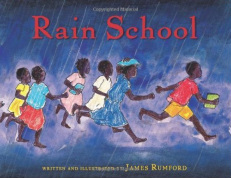 Rain school by James Rumford
Houghton Mifflin Harcourt, 2010
It is the first day of school for Thomas and the other children of his village in Chad. When Thomas and the other children arrive there is no school building, just a teacher. The students' first lesson is how to build a school from the ground up, as they do every year after the summer rainy season.
Rain school stems directly from James Rumford's experience as a Peace Corps volunteer in Chad and his knowledge shows. Many details, from the patterns of fabric to the local fauna, make it evident that he is familiar with the country. The backgrounds of the illustrations are predominantly shades of yellow and orange, which not only gave me a sense of heat but also provide an appropriately joyous atmosphere to the book.
It is difficult for many of us to imagine having to build a school every September in order to have a place to learn or teach. However, people in many parts of the world are not as lucky as we are and need to go above and beyond simply to learn, and Rain school is a delightful introduction to the topic.
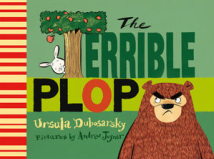 The Terrible Plop by Ursula Dubosarsky with pictures by Andrew Joyner
Penguin Books for Children, 2009
The Terrible Plop is a book that starts
With a PLOP that trembles the rabbits' hearts.
They start to run and when they do
The forest critters follow, too.
While all the creatures run away
The big brown bear decides to stay.
What will happen when the bear goes to see
The PLOP that's causing everyone to flee?
In rollicking text that has a pleasing rhyme,
This book is joy at read-aloud time.
A touch of mystery, colourful art,
and humour set Terrible Plop apart.
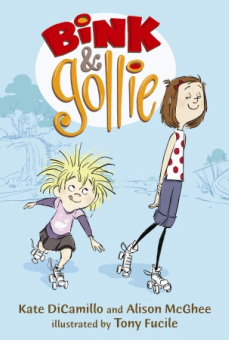 Bink & Gollie by Kate DiCamillo and Alison McGhee, illustrated by Tony FucileCandlewick, 2010 Bink, a small girl with wild blonde hair, lives in a homey little cottage while Gollie, a tall brunette, lives in a tidy modern home in a tree (yes, a treehouse!). Through the course of three short chapters, the girls have small adventures which demonstrate the ups and downs of friendship. Bink & Gollie is absolutely delightful. The girls, apparent best friends and near-constant companions, seem to have little in common. Gollie has an outwardly calm demeanor and uses a charmingly old-fashioned vocabulary - '"Greetings, Bink," said Gollie. "I long for speed"' (p. 3). Bink, on the other hand, has a disheveled look about her and her actions are propelled by emotion and other drives, such as hunger. Together, they work to find compromises when they have disagreements and do their best to see one another's perspective. The illustrations are as charming as the characters themselves. Tony Fucile uses colour to accentuate components in his predominantly grey-scale drawings, from signs in store windows to a new goldfish. Bink and Gollie themselves are always in full colour, and one touch I especially enjoyed was the smudge of orange to indicate Fred in the frozen pond on the final page. Although there are many details within the illustrations (like Gollie's treehouse, which I now covet), care was taken not to detract from the two girls. A wonderful collaboration (which makes me wonder if DiCamillo is more like Bink and McGhee is more like Gollie, or vice versa*) with an endearing result. *Read this article to find out!
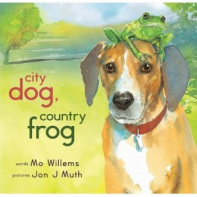 City dog, country frog by Mo Willems, illustrated by Jon J. Muth
Hyperion, 2010
When City Dog arrives for a visit to the country in springtime, he heads off for a gleeful leash-free run and encounters Country Frog. When asked why he is sitting on a rock, Country Frog replies that he is waiting for a friend, but that City Dog will do. Thus begins a friendship that lasts through the seasons.
Picture books of friendship don't come much more poignant than this. Mo Willems is a master of subtly injecting emotion into the play of words and images in his books, and combining his words with Jon J. Muth's expressive watercolour illustrations is a match made in heaven. The colours capture the essence of the four seasons and the animals have obvious personalities. City Dog's tail and ears are consistently perfect, and in the image below his confusion at Country Frog's absence is evident. The illustrations extend Willems' carefully selected words and, in keeping with the origins of the word, beautifully illuminate them.
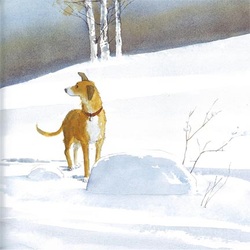 Image from: http://32pages.ca/2011/01/07/a-dog-a-frog-and-an-apology/ I'm not going to lie: I've read this book three times and I've been misty-eyed on every occasion. You see, Country Frog doesn't survive past autumn and City Dog persists in waiting for him to reappear into the following spring. (Lest you think the book ends on a sad note, rest assured that City Dog befriends another country creature.) Bittersweet and beautiful it most certainly is, and well worth a look.
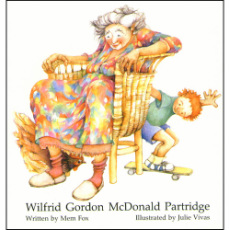 Wilfrid Gordon McDonald Partridge by Mem Fox, illustrated by Julie Vivas
Kane Miller, 1984
Wilfrid Gordon McDonald Partridge is four years old and lives next door to an "old people's home," where he has numerous friends. He overhears that his best friend Miss Nancy lost her memory, but Wilfrid doesn't know what memory is. When he asks all his friends at the home about it, he gets a variety of answers that he interprets in his own way to help Miss Nancy.
What a truly lovely book. It contains what I consider to be the essential components of a wonderful picture book: a deceptively simple story, concisely told and relatable, with gorgeous illustrations. Mem Fox and Julie Vivas certainly deliver that here, and the collaboration is such that the sum of the writing and illustrations is greater than the two parts. Every word is absolutely necessary, and each illustration is luminous and expressive.
In my experience, there are not many picture books that address intergenerational friendships. In fact, this is the only one I've come across in which the relationships depicted are purely friendships and the child is not related to any of the elderly characters. It is refreshing and wonderful and I hope there are more like it that I simply haven't found yet.
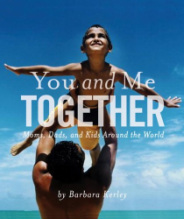 You and me together: Moms, Dads, and kids around the world by Barbara KerleyNational Geographic Society, 2005With spare, rhythmic text and gorgeous photographs from all around the world, You and me together looks at the common experiences shared by parents and children regardless of culture, language, nationality, or religion. This is an absolutely gorgeous book. The photos all have a parent with one or more children partaking in activities described by the text, from playing with a ball to riding ponies to just having a chat. Each photo in the book (including the cover image) has a brief caption at the back explaining where the photograph was taken and something interesting about the subjects or event depicted in the image. Although North America is the continent depicted most often in the book, the images cover all continents (except Antarctica). Although one spread in particular that shows a young Karen girl gazing at her guitar-playing mother with an expression of absolute adoration just about undoes me, You and me together is chock full of lovely everyday moments between children and their parents. Most of the children depicted in the images fall within the 4- to 8-year-old age group, which is likely the target child audience. An outstanding book to demonstrate for young children the similarities and differences between cultures.
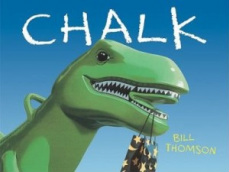 Chalk by Bill Thomson
Marshall Cavendish, 2010
On a rainy day, three children go to the park to play. When they find a bag full of sidewalk chalk and start drawing on the asphalt, they discover that whatever they draw becomes real. A sun dissipates the rain, a swarm of butterflies flies all around, and a Tyrannosaurus Rex fast becomes more terrifying than anticipated.
Wordless books are some of my favourite picture books, and Chalk is no exception. Without words, illustrations become paramount and Bill Thomson makes his acrylic and colored pencil drawings look almost like photographs: the reflections are bright and the different textures (skin, plastic, fabric) are realistic. The children's facial expressions when they discover the power of the chalk are wonderful, with one girl appearing almost crazily delighted and the boy looking very mischievous (guess who draws the carnivorous dinosaur?). I particularly loved the spread where monarch butterflies were magically taking flight from the asphalt.
Thomson uses perspective to his great advantage as well, by showing one of the frightened children fleeing up a playground ladder from below to accentuate her wide-eyed, wide-mouthed terror at being chased by a T. Rex. The perspectives he used created tension themselves, such as when the reader is in the covered slide with two of the children looking out at the dinosaur's menacing teeth, and the scene involving the demise of the T. Rex is masterfully done.
I hope Bill Thomson makes more like Chalk, as it's remarkable.
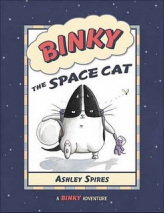 Binky the space cat by Ashley Spires
Kids Can Press, 2009
This book is hilarious and I adore it. That is all.
No, not really, but that is definitely my overall sentiment about this graphic novel for elementary-age children. Binky the cat, who trains ceaselessly (except for napping and eating, of course) to become an effective space cat who keeps the omnipresent "aliens" (bugs) away from his humans, has fast become my favourite cat in children's fiction.
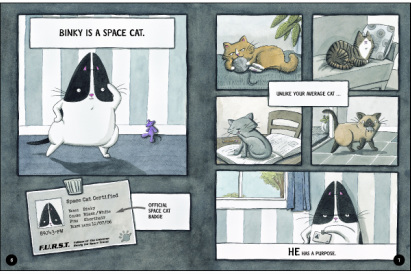 Image from: http://www.kidscanpress.com/US/Binky-the-Space-Cat-P3150.aspx The humour in this book is spot on, especially for anyone who has spent much time with a cat and knows their habits and quirks. The pages when Binky tries to help out around the house but manages to do quite the opposite is a hoot, as are Binky's attempts to dote on his humans. It has a Toy Story sensibility in the sense that Binky pursues his projects under the humans' noses without their knowledge, partaking in nighttime raids and research on the sly, complete with reading glasses stowed under the chair cushion. While some of the subtler jokes probably won't be caught by children, like the cover image homage to the inevitable slow-motion scene in Apollo 13 and the like wherein the astronauts stride heroically toward the spacecraft prior to take-off, Binky's "space gas" from eating particularly crunchy bugs will definitely get some giggles. Again, loved it, and I can't wait to get my hands on any other Binky books out there.
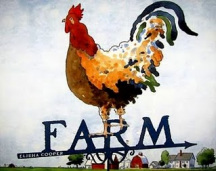 Farm by Elisha Cooper
Orchard Books (Scholastic), 2010
Farm takes readers from early spring through to late autumn on a modern family farm. Although it is strictly speaking a fictional picture book, Farm reads much like nonfiction with it's descriptive chronological text. At the end, I felt as if I had watched a months-long, time-lapse film of the farm.
Cooper's text, while concise, results in a very atmospheric book. Phrases like "even the clouds seem to make sound as they bump across the sky"* and "to the south are more cornfields, which smell sort of buttery" permeate the book with evocative details of farm life. It is these details, the minutiae of farm life from squeaking corn to the smell of the barn, that made me feel as if I had been there. Despite the detail the text manages to show the reader instead of telling them, leaving me to fill in blanks.
The use of white space in the watercolour illustrations also reflect this sense of filling in blanks. From the farm animals to the children doing chores, all are illustrated with a stark white background, and without much detail except for some animal close-ups. The feeling of wide open spaces is tangible when Cooper shows panoramas of the farm, which are dominated by the sky filling the vast majority of the page.
A subtle humour is at play as well, which I enjoyed: describing the lazy activities of the month of June, "Bear [the cat] plays with a snake then eats it (some animals enjoy June more than others)." A bit dark? Sure. But the cycle of life is alluded to every so often in Farm, and rightly so.
This is a poetic and evocative book about the day-to-day, season-to-season life on a family farm. Lovely.
*I would provide page numbers for quotes but the book is not paginated.
|











 RSS Feed
RSS Feed